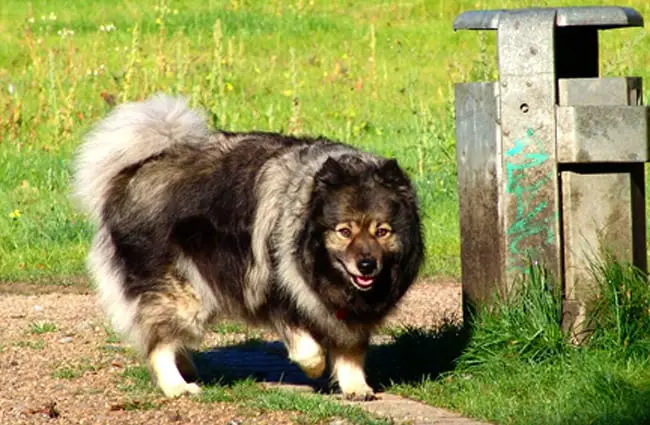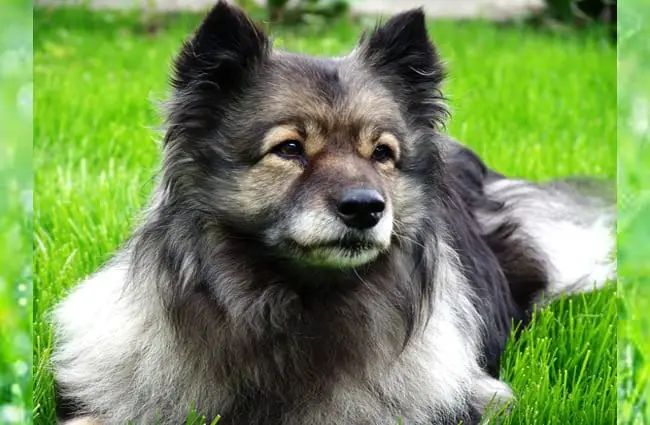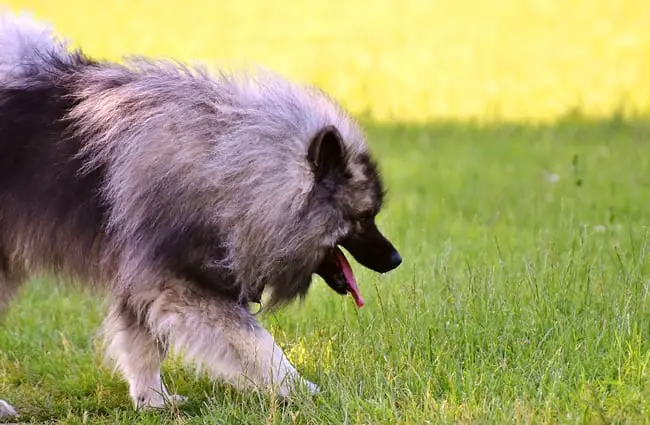Welcome, fellow enthusiasts of the natural world, to a journey into the captivating realm of the Keeshond. Often described as a “smiling Dutchman,” this magnificent canine offers far more than just a charming face. From its ancient lineage to its modern role as a beloved family member, the Keeshond presents a fascinating case study in domestication, adaptation, and the enduring bond between humans and animals.
As a zoologist who has ventured into the world of popular science writing, the Keeshond stands out as a prime example of how selective breeding and cultural integration can shape a species. This article will delve into every facet of this remarkable breed, providing insights for students, aspiring zoologists, animal lovers, and anyone curious about the furry wonders that share our planet.
Unveiling the Keeshond: A Glimpse into its World
The Keeshond, pronounced “Kays-hawnd,” is a medium-sized dog breed belonging to the Spitz family. Originating from the Netherlands, it is instantly recognizable by its striking silver and black coat, lion-like mane, curled tail, and the distinctive “spectacles” around its eyes. These markings give it an alert and intelligent expression, often appearing as if the dog is wearing glasses.
Beyond its striking appearance, the Keeshond is renowned for its delightful temperament. They are typically cheerful, intelligent, and highly social animals, thriving on human companionship. Their playful nature and eagerness to please make them excellent family pets, often forming strong bonds with children and other animals.

Physical Characteristics: A Study in Spitz Elegance
The Keeshond’s physical attributes are a testament to its Spitz heritage, designed for both beauty and resilience.
- Size: Males typically stand 17 to 18 inches (43 to 46 cm) at the shoulder, weighing 45 to 55 pounds (20 to 25 kg). Females are slightly smaller.
- Coat: A defining feature is its luxurious double coat. The outer coat consists of long, harsh, straight hair, while the undercoat is thick, soft, and woolly. This dense insulation protects them from both cold and heat.
- Coloration: The standard color is a mixture of grey, black, and cream, with distinct markings. The “spectacles” are created by a line of black hair slanting from the outer corner of each eye towards the lower corner of the ear, combined with expressive eyebrows.
- Tail: The tail is tightly curled over the back, often resting against the back, and is profusely plumed.
- Ears: Small, triangular, and erect, set high on the head.
Temperament and Behavior: The Heart of a Companion
Keeshonds are celebrated for their endearing personalities. They are:
- Affectionate: Known for their deep devotion to their families, they thrive on interaction and attention.
- Intelligent: Highly trainable and eager to learn, they excel in obedience, agility, and other dog sports.
- Alert: Historically used as watchdogs on barges, they retain a keen awareness of their surroundings and will often bark to alert their owners to newcomers.
- Playful: They maintain a puppy-like enthusiasm well into adulthood, enjoying games and interactive play.
- Social: Generally good with children and other pets, provided they are properly socialized from a young age.

A Deep Dive into Keeshond Life: For the Aspiring Zoologist and Dedicated Owner
Evolutionary History: From Ancient Canines to Dutch Barges
The Keeshond’s lineage traces back to the ancient Spitz-type dogs of the Arctic and sub-Arctic regions. These dogs, characterized by their thick fur, pointed ears, and curled tails, were among the earliest domesticated canines, valued for their resilience and utility in harsh environments.
- Spitz Family Roots: The Keeshond shares ancestry with breeds like the Samoyed, Chow Chow, Pomeranian, and Norwegian Elkhound. These dogs were developed across Eurasia for various roles, including herding, hunting, and guarding.
- Dutch Origins: The specific development of the Keeshond occurred in the Netherlands, where they became known as “Dutch Barge Dogs” or “Ferry Dogs.” For centuries, they lived on river barges and canal boats, serving as vigilant watchdogs and loyal companions to the boatmen and their families. Their role was to alert the crew to any approaching strangers or unusual activity.
- Political Symbolism: In the 18th century, the Keeshond became a symbol of the Dutch Patriot political party, led by Cornelis de Gyselaer, whose dog was named Kees. The breed’s association with the common people and their resistance to the House of Orange cemented its place in Dutch history. After the Patriot party’s defeat, the breed’s popularity waned for a time, but dedicated enthusiasts ensured its survival.
- Modern Recognition: The breed was revitalized in the early 20th century, largely due to the efforts of Baroness van Hardenbroek. It gained international recognition and was officially named the Keeshond.
Habitat and Environment: A Domesticated Existence
It is crucial for any animal lover or aspiring zoologist to understand that the Keeshond is a thoroughly domesticated animal. Unlike wild canids, Keeshonds do not possess a natural “habitat” in the wild where they can be found thriving independently.
- Primary Habitat: The Keeshond’s primary habitat is the human home. They are companion animals, deeply integrated into family life. They thrive in environments where they receive consistent human interaction, mental stimulation, and physical exercise.
- Adaptability: Thanks to their dense double coat, Keeshonds are well-suited to cooler climates. However, their coat also provides insulation against heat, though care must be taken to prevent overheating in very warm weather. They can adapt to various living situations, from apartments to houses with yards, as long as their exercise and social needs are met.
- Ancestral Environment (Historical Context): Historically, their “habitat” was the confined space of a river barge. This environment fostered their watchful nature and strong bond with their human family, as they were constantly in close proximity. This history explains their preference for being near their people and their tendency to be vocal alarms.

Diet and Nutrition: Fueling the Fluffy Friend
A Keeshond’s diet, like that of any domesticated dog, is primarily composed of commercially prepared dog food formulated to meet their nutritional needs. However, understanding the specifics is vital for their health.
- Balanced Commercial Diet: High-quality dry kibble or wet food, appropriate for their age, activity level, and size, forms the cornerstone of their diet. Look for foods with meat as the primary ingredient.
- Portion Control: Keeshonds can be prone to weight gain if overfed. Daily caloric intake should be carefully monitored, typically split into two meals.
- Treats: Healthy treats can be used for training, but moderation is key. Avoid excessive fatty or sugary treats.
- Hydration: Constant access to fresh, clean water is essential.
- Dietary Considerations: Some Keeshonds may have sensitivities or allergies, requiring specialized diets. Consultation with a veterinarian is always recommended for specific dietary plans or concerns.
Mating and Reproduction: Responsible Breeding Practices
Keeshond reproduction follows the general patterns of domesticated canines, with a strong emphasis on responsible breeding to maintain breed health and temperament.
- Sexual Maturity: Females typically reach sexual maturity between 6 and 12 months, experiencing their first estrus cycle (“heat”). Males mature slightly later. However, responsible breeders wait until dogs are fully mature (usually around two years of age) and have undergone health screenings before breeding.
- Estrus Cycle: Females typically cycle twice a year. The fertile period within the cycle is relatively short.
- Gestation: The gestation period for dogs is approximately 63 days.
- Litter Size: Keeshond litters typically range from 4 to 8 puppies.
- Responsible Breeding: Ethical breeders prioritize the health and welfare of the breed. This includes:
- Health testing parents for genetic conditions common in the breed (e.g., hip and elbow dysplasia, patellar luxation, eye conditions, thyroid issues).
- Maintaining excellent temperament in breeding stock.
- Providing proper prenatal and postnatal care for the mother and puppies.
- Socializing puppies from an early age.
- Ensuring puppies go to responsible, loving homes.

Ecosystem Contribution and Interaction with Other Animals
As domesticated animals, Keeshonds do not play a direct role in wild ecosystems. Their “contribution” is primarily within the human social and domestic sphere. However, their presence can have indirect effects.
- Within the Human Ecosystem:
- Companionship: Their primary role is to provide companionship, emotional support, and joy to their human families. This significantly impacts human well-being.
- Watchdogs: They serve as excellent alarm systems, alerting owners to intruders or unusual activity, thus contributing to household security.
- Therapy Animals: Their gentle and affectionate nature makes some Keeshonds suitable as therapy or emotional support animals.
- Interaction with Other Domestic Animals:
- Other Dogs: Generally friendly and playful with other dogs, especially if well-socialized.
- Cats and Small Pets: With proper introduction and supervision, many Keeshonds can coexist peacefully with cats and other small household pets. Their prey drive is typically low compared to some other breeds.
- Interaction with Wildlife (Indirect Impact):
- Responsible Ownership: When kept on a leash and confined to secure areas, Keeshonds have minimal impact on local wildlife.
- Irresponsible Ownership: An unleashed Keeshond, like any dog, could potentially chase or disturb wildlife, or even transmit diseases to wild populations, though this is not a breed-specific trait but rather a consequence of irresponsible pet ownership.
Contribution to Human Culture and Interaction with Humans
The Keeshond’s contribution to human culture is rich and multifaceted, deeply intertwined with its history and temperament.
- Historical Significance: As the “Dutch Barge Dog,” they were integral to the daily lives of canal boatmen, symbolizing reliability and companionship. Their role as a mascot for the Patriot party in the 18th century cemented their place in Dutch political history.
- Symbol of Companionship: Today, they embody the ideal companion dog: loyal, affectionate, intelligent, and adaptable. They represent the joy and comfort that pets bring to human lives.
- Art and Literature: While perhaps not as frequently depicted as some other breeds, the Keeshond’s distinctive appearance and charming personality have found their way into various forms of art and literature, celebrating their unique appeal.
- Therapeutic Role: Their empathetic nature makes them excellent candidates for therapy work, bringing comfort and joy to individuals in hospitals, nursing homes, and schools.
- Deep Human Bond: Keeshonds form incredibly strong bonds with their human families. They are known for their desire to be involved in all family activities, often following their owners from room to room. Their communication involves a range of barks, whines, and expressive body language, making them highly interactive companions.

Interesting Facts and Practical Insights
A Huge List of Interesting Keeshond Facts
- The Keeshond is sometimes referred to as the “Smiling Dutchman” due to its cheerful expression and Dutch origins.
- They are part of the Northern Spitz group, which includes other cold-weather breeds.
- The breed’s name, “Keeshond,” is believed to come from “Kees,” a common Dutch nickname, and “hond,” meaning dog.
- Their distinctive “spectacles” are a breed hallmark and are formed by the unique pattern of black hair around their eyes.
- Keeshonds are known for their “velcro” personality, always wanting to be close to their human family members.
- Despite their thick coat, they are relatively clean dogs and do not have a strong “doggy” odor.
- They are excellent watchdogs, quick to bark at anything unusual, but rarely aggressive.
- The Keeshond was recognized by the American Kennel Club (AKC) in 1930.
- They are highly intelligent and excel in dog sports like obedience, agility, and rally.
- Their double coat requires regular grooming, but it is surprisingly easy to maintain with consistent brushing.
- Keeshonds are known for their playful nature, often retaining a puppy-like demeanor well into their senior years.
- They are generally good with children and other pets, making them ideal family dogs.
- Historically, they were known as “Dutch Barge Dogs” because they lived and worked on river barges and boats.
- The breed nearly disappeared after the defeat of the Patriot party in the Netherlands in the late 18th century.
- They are considered a “natural” breed, meaning they have not undergone extreme modifications through selective breeding.
Encountering a Keeshond in the “Wild” and What to Do
It is vital to reiterate: Keeshonds are not wild animals. If you encounter a Keeshond “in the wild,” it is almost certainly a lost or abandoned pet. This situation requires a compassionate and responsible approach.
- Do Not Approach Hastily: Even a friendly dog can be scared and unpredictable when lost. Approach calmly and speak in a soft, reassuring voice.
- Check for Identification: Look for a collar with tags, which may include contact information.
- Contain Safely (If Possible): If the dog seems friendly and approachable, try to safely contain it, perhaps by luring it into a fenced area or with a leash if you have one.
- Contact Local Authorities: Immediately contact your local animal control, humane society, or police department. Provide a detailed description of the dog and the location where it was found.
- Post “Found Dog” Notices: Utilize social media, local community groups, and physical posters to help reunite the dog with its owner.
- Do Not Assume Abandonment: Many lost pets are deeply loved and missed. Every effort should be made to find their rightful owners.
Caring for a Keeshond in a Controlled Environment: A “Zookeeper’s” Guide
While Keeshonds are not typically found in traditional zoos, the principles of excellent animal husbandry apply whether caring for a wild species or a domesticated breed in a rescue facility, breeding program, or even a dedicated home. For a “zookeeper” caring for a Keeshond, the following tasks and considerations are paramount:
- Daily Tasks:
- Feeding: Provide a consistent, measured diet of high-quality dog food twice daily. Monitor consumption and adjust as needed.
- Water: Ensure constant access to fresh, clean water.
- Grooming: Daily brushing is ideal to prevent mats and reduce shedding, especially for their dense double coat. Pay attention to areas behind the ears, under the legs, and around the tail.
- Exercise: Provide at least 30-60 minutes of moderate exercise daily, such as walks, playtime in a secure yard, or engaging in dog sports.
- Mental Stimulation: Offer puzzle toys, training sessions, and interactive games to keep their intelligent minds engaged.
- Socialization: Ensure regular positive interaction with humans and, if appropriate, other well-socialized dogs.
- Health Checks: Perform daily visual checks for any signs of illness, injury, or discomfort (e.g., changes in appetite, lethargy, limping, skin issues).
- Weekly/Monthly Tasks:
- Bathing: Bathe as needed, typically every 4-6 weeks, using a dog-specific shampoo. Ensure the coat is thoroughly dried to prevent skin issues.
- Nail Trimming: Trim nails every 2-4 weeks to prevent overgrowth and discomfort.
- Ear Cleaning: Check and clean ears weekly to prevent infections.
- Dental Care: Brush teeth several times a week and provide dental chews.
- Coat Maintenance: A thorough line-brushing session weekly to remove dead undercoat.
- What to Avoid:
- Isolation: Keeshonds are highly social and can suffer from separation anxiety if left alone for long periods. Avoid prolonged isolation.
- Neglecting Grooming: Their thick coat will quickly mat if not regularly brushed, leading to skin problems and discomfort.
- Lack of Exercise/Stimulation: A bored Keeshond can become destructive or excessively vocal.
- Harsh Training Methods: They respond best to positive reinforcement and gentle, consistent training.
- Overheating: Due to their dense coat, avoid strenuous exercise during the hottest parts of the day. Provide shade and water.
- Ignoring Vocalizations: While they can be barkers, understand that barking is their primary way of communicating. Address the cause rather than simply punishing the symptom.
The Enduring Charm of the Keeshond
From the bustling waterways of the Netherlands to the comfort of modern homes, the Keeshond has journeyed through history, evolving from a vigilant barge dog to a cherished family companion. Its unique blend of intelligence, affection, and striking appearance makes it a truly special breed.
Understanding the Keeshond, whether for academic research, responsible ownership, or simply out of curiosity, reveals the intricate tapestry of canine evolution and the profound impact these animals have on human lives. The “Smiling Dutchman” continues to bring joy and companionship to countless individuals, a testament to its enduring appeal and the deep connection we share with the animal kingdom.






![Red Angus Closeup of a beautiful Red Angus cowPhoto by: U.S. Department of Agriculture [pubic domain]https://creativecommons.org/licenses/by/2.0/](https://animals.net/wp-content/uploads/2020/03/Red-Angus-4-100x75.jpg)

